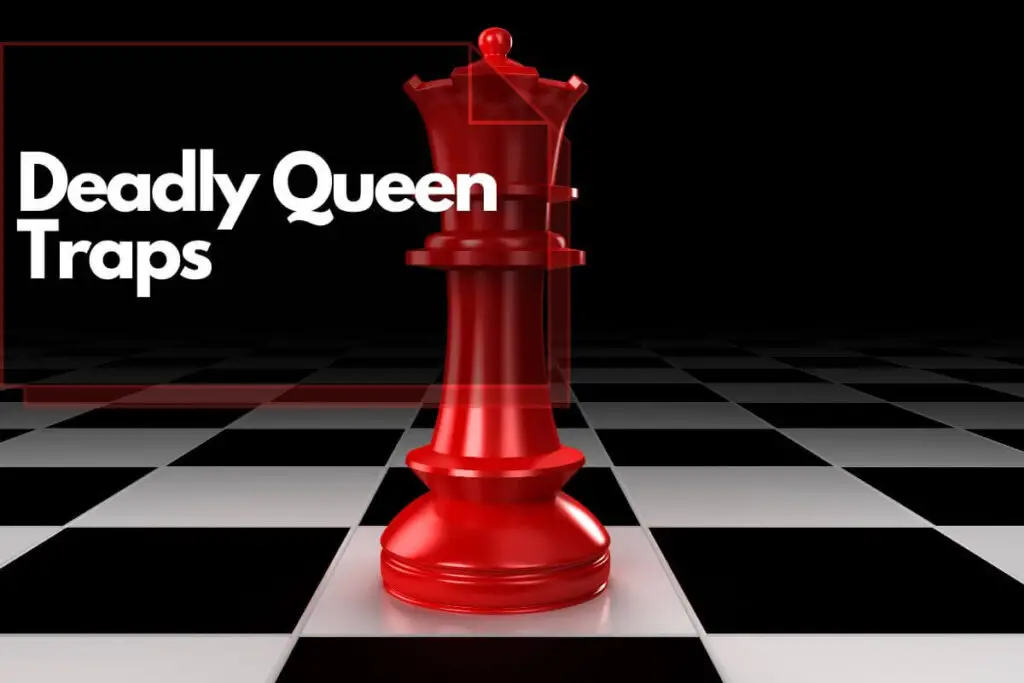The queen is the most powerful and mobile piece on the chessboard. To capture her for little or no compensation is a great feat and almost always spells the end of the game.
Because the queen can roam great distances quickly and moves like a rook and bishop combined, the idea of trapping her seems highly improbable. However, the very power and mobility of the queen can lead to her downfall.
The player is lulled into a sense of the queen’s immortality and doesn’t take heed of subtle booby traps in her path; he guides her into enemy territory, lured by the opportunity to grab material. To trap a queen is a delicate art; nonetheless, it happens frequently in chess.
More often than not it is the barrier of her own pawns combined with subtle tactics that cause the lady’s down fall. The queen trap is usually quite shocking for the victim.
In this article, we will take a look at 5 of the best queen traps in chess. These traps are quite common and happen as early as in the opening. Therefore, they can be applied in your own games. With that said let’s jump right in.
Top 5 Queen Traps To Trick Your Opponent
Queen Trap#1: French Defense Rubenstein Variation
Our first queen trap is in the Rubenstein Opening of the French Defense. It begins with the moves 1.e4 e6 2.d4 d5 3.Nd2 dxe4 4.Nxe4

Black then develops his knight to f6 via 4…Nf6.
This move is frowned upon because white can now capture the knight on f6. After 5.Nxf6 Qxf6 6.Nf3, the black queen is somewhat misplaced on f6 as white can attack it with the move Bishop g5.

This doesn’t particularly threaten to trap the queen, but it does gain a valuable tempo off the queen. However, if Black is not careful, white can set up a queen trap on the next move via Bd3 and then play Bg5 to trap the queen. As a result, Black’s best move in this position is to play 6…h6 which takes away the square on g5 for the bishop. 6…Qd8 is also a good alternative which retreats the queen to a safer square.
In the game 6…Bd6? 7.Bd3 was played. White is one move away from trapping the black queen.
Notice how all the squares are controlled by the white pieces. The black queen will not have a safe square to retreat after white delivers the final blow. Black should see the threat and retreat his queen to d8 or play h6.
7…0-0?? 8.Bg5!
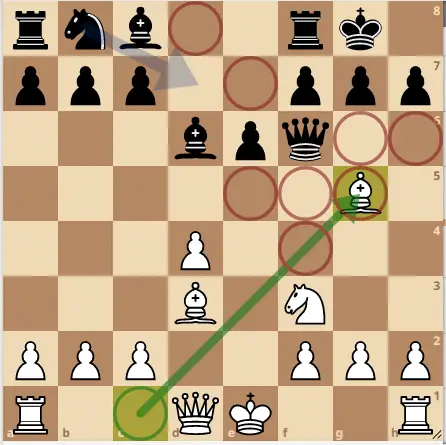
Black did not see the threat and castled kingside. White plays Bishop to g5 trapping the Black queen with no escape square to go.
The key takeaway from this queen trap is to avoid bringing out your queen early in the opening. Black should have played 4…Nbd7 to prepare the move Nf6. This means the knight would recapture on f6 instead of the queen. When you bring out your queen too early in the opening, it is exposed to all sorts of attacks from the opposing side. This could lead to the queen’s demise.
According to my experience playing the rubenstein variation of the french defense, I’ve had a lot of successes using this trap even with intermediate players. On the other hand, a strong opponent will usually see the threat and prevent it from happening. So it all depends on the level of player you are up against.
Queen Trap#2: Fajarowicz Gambit Queen Trap 1
This is one of my favorite queen traps in the opening. The Fararowicz opening is a variation of the Budapest defense which begins with the moves 1.d4 Nf6 2.c4 e5 3.dxe5 Ne4

The best moves for white are 4.a3 or 4.Nf3. Here we will see what happens after white plays 4.a3.
The queen trap is set up by the dubious move 4…b6.
This move induces white to play 5.Qd5 which appears to fork the knight on e5 and the rook on a8. But as you’ll see, black has a trick up his sleeves.

5…Bb7 6.Qxb7 Nc6
Black is going to use his two knights to gain access to key squares on the queenside which will create a net for the queen. The best move for white here is to play 7.b4. This prevents black from playing Nc5, which would trap the queen on b7.

7.Qa6??
This is a blunder. White wants to get out of the entanglement but by doing so, puts his queen into a bad position. Black now get in the move 7…Nc5, and after 8.Qb5 a6! the white queen is trapped.
Though black played very dubiously in the opening, he was able to trap white’s queen. White simply did not calculate properly or he would have seen the queen trap that his opponent was setting up for him.
After 9.Qxc6 dxc6 Black is up a queen for two minor pieces which should seal him victory.
Queen Trap#3: Fajarowicz Gambit Queen Trap 2
The first move order of this queen trap is similar to our previous example, instead white plays 4.Nf3 instead of 4.a3.
Black will continue his trap by playing 4…b6 5.Qd5 Bb7. However, this time it comes with a small twist.
Black lures the queen to capture on b7
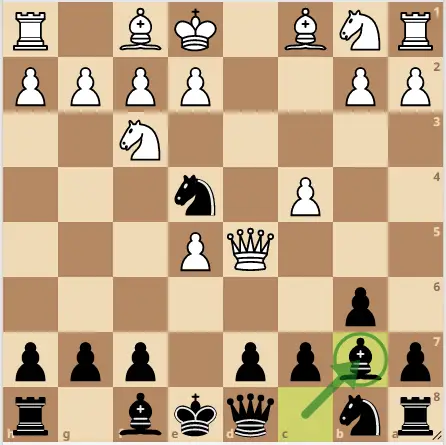
6.Qxb7 Nc6 7.Qa6
Again, white tries to escape his queen out of the net, but it turns out to be a blunder. The better move 7.Nd4 temporarily giving up the knight.
Now, if black should trap the queen, he needs to add a twist to it. If you stare close at the positon, Nc5 doesn’t work again because the white queen can escape to the a3 square. Previously, there was a pawn on a3.

To successfully trap white’s queen, black needs to deliver a check with his bishop instead of the immediate knight to c5. This gets the bishop out and controls the a3 square, which prevents the white queen from retreating to that square.
7…Bb4+ 8.Bd2 Nc5! 9.Qb5 Bxd2+ 10.Nbxd2 a6
The white queen is trapped. At best, the queen can capture on c6. But black will be up a queen for 2 minor pieces.
Queen Trap#4: Scandinavian Defense Tennison Gambit Queen Trap
This next queen trap is a gambit that you can play when your opponent uses the Scandinavian Defense. A gambit is a opening strategy in which a player sacrifices his material of lesser value such as a pawn, with the hope to achieving an advantageous position.
The idea is to lure your opponent to capture your material(s) for free and then you come up with a solid sequence of move to capture a major piece such as a queen. This trick is something you should not miss.
The game begins 1.e4 d5

This is the Scandinavian Defense. After this move, you start setting out your trap. The most popular move is to take the pawn on d5, but instead we will play 2.Nf3.
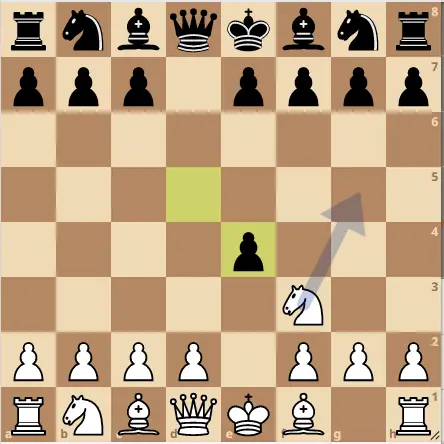
The most natural move for Black is to capture the pawn on e4, after which white plays knight to g5.
3…Nf6 4.d3
White sacrifices another pawn with the hope of gaining activity for his pieces. This is a bit dubious as black can gain a slight advantage with the move 4…Bg4.
Nevertheless, most players here will capture the pawn on d3, claiming advantage in material.

After 4…exd3 5.Bxd3 h6 white can execute his attack against the black king.
White sacrifices his knight on f7. The black king is forced to capture the knight. But after Bg6+, all of a sudden the black queen on d8 is unprotected and the king has a check to deal with. Black would love to defend his queen on d8, but after 7…Kxg6, White captures the undefended queen on d8.
White gambit his pawns and sacrificed two of his minor pieces to win Black’s queen in the end. White is up a whole queen for 2 minor pieces. Not to mention the black king has lost castling rights, and is out vulnerable in the opening.
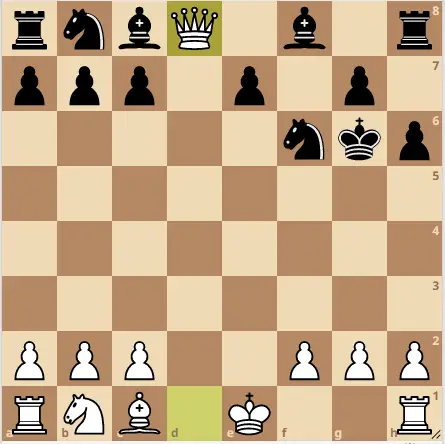
The reason why white was successul in trapping the queen is that Black was greedy for material and did not see that his pieces ought to be developed.
Queen Trap#5: Queen’s Gambit Declined: Exchange Variation
Our final queen trap is a very popular line in the Queens Gambit Declined Opening. I’ve had many successes with this trap especially with beginner and intermediate players. The position reaches after the moves 1.d4 d5 2.c4 e6 3.Nc3 Nf6 4.cxd5 exd5 5.Bg5 Nbd7

The idea of playing Nbd7 is to lure white into capturing on d5. This appears to win a pawn because it seems that Black’s Knight is pinned to his queen. But after closer inspection, there is a trap in the position. If white goes ahead and captures the d5 pawn with his knight, black can sacrifice his queen, but gets back white’s queen and knight in the process.
6.Nxd5 Nxd5! 7.Bxd8 Bb4+

White has to block the check with his queen, thereby giving up his queen on d2 as the White king has no escape squares, nor any other pieces to block.
Black doesn’t even need to hurry and capture back the queen. Black captures the bishop on d8 instead. On the next move black may recapture the queen, or force white’s queen to capture on b4.
Final Verdict
Trapping your opponent’s queen can sometimes be dubious. If it doesn’t work out, you could be left with a bad position.
But, if your opponent is disobeying basic opening principles, then you should go ahead with your plan in mind. They key is to use your pawns and pieces to take away crucial squares in the position, then when the time is right, you deliver the final blow and trap his queen.
Credits: Chess Talk Youtube Channel

